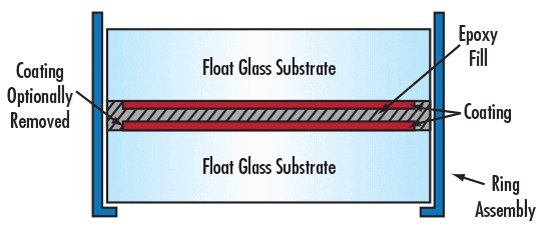Traditional soft coatings, commonly used for optical components, may soon be overshadowed by a more advanced technique known as hard coating. Hard coatings offer numerous advantages over traditional soft coatings.
Soft Coatings
Soft coatings are composed of multilayer thin films made from materials like zinc sulfide, cryolite, and sometimes silver. For traditional interference filters, these coatings are laminated in a vertical stack to offer some protection from environmental factors and are typically cut from larger wafers.
Due to the materials and production methods, soft coatings are delicate. The coating is often removed from the filter edges to prevent moisture degradation and extend the coating’s lifespan. Figure 1 illustrates the final product.
The cost of soft coatings remains relatively low due to inexpensive deposition equipment, quick cycle times, and cost-effective float glass substrates. However, handling costs are high due to sealing and ring assemblies.
The cost versus volume ratio follows an asymptotic trend: expensive at low volumes, stabilizing only after the production of several dozen 1-inch pieces or a few 2-inch or larger pieces.

Hard Coatings
Hard coated films are created using a plasma deposition process that offers significant benefits over soft coatings. This process is precisely controlled by computer systems, resulting in uniform layering, better environmental resistance, and enhanced performance. For example, hard coatings provide more consistent transmittance across different wavelengths and generally outperform soft coatings.
As demonstrated in Figure 2, hard coatings can achieve over 90% transmission throughout the visible spectrum and into the UV range. In contrast, soft coatings struggle to reach 90% transmission and show notable performance drops near the UV spectrum. Furthermore, hard coatings feature sharper cut-on and cut-off transitions compared to the gradual transitions of soft coatings, enhancing their overall performance.


